Decoding the Owl Symbol – Understanding Its Meaning Across Cultures
The owl carries profound symbolic weight across various cultures and historical contexts. In Ancient Greek mythology, it represents wisdom and strategic acumen, closely associated with the goddess Athena.
Native American tribes hold diverse views, seeing the owl as both a death harbinger and a spiritual guide. Eastern cultures revere it for its wisdom and protective qualities, while Medieval European societies link it to knowledge and mystery.
Modern interpretations range from emblems of conservation to symbols of intelligence in popular culture. Owls embody a duality of enlightenment and forewarning, enriching their presence in literature and art.
Discovering more about this enigmatic creature reveals deeper insights across traditions.
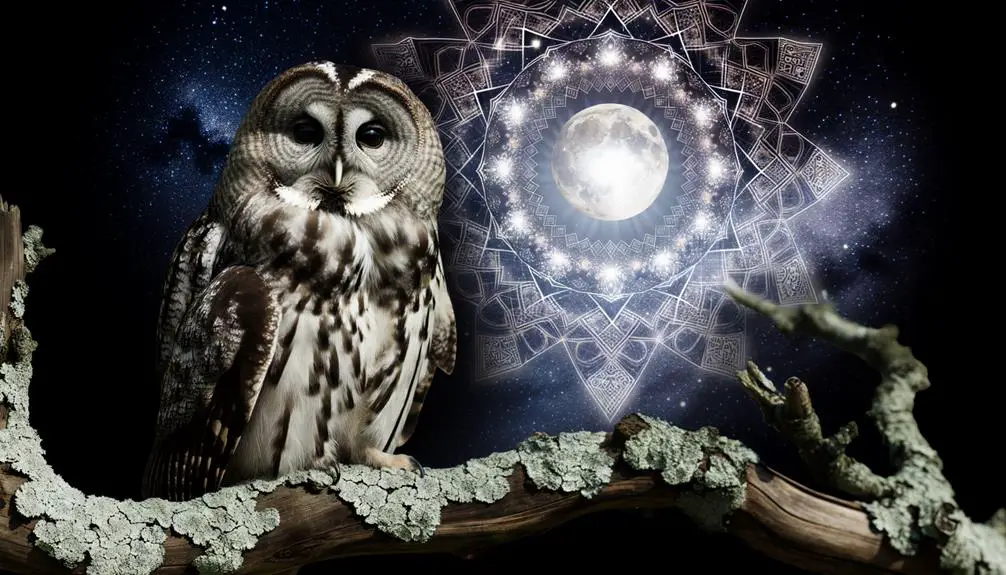
Key Takeaways
- Owls symbolize wisdom, intellectual prowess, and strategic acumen across various cultures.
- In Native American beliefs, owls represent the paradoxes of life and death, as well as physical and spiritual journeys.
- Eastern traditions view owls as emblems of wisdom, guardianship, and enlightenment.
- Medieval European views associate owls with knowledge, mystery, and the supernatural.
- Modern interpretations see owls as messengers of deeper truths and symbols of conservation.
Ancient Greek Mythology
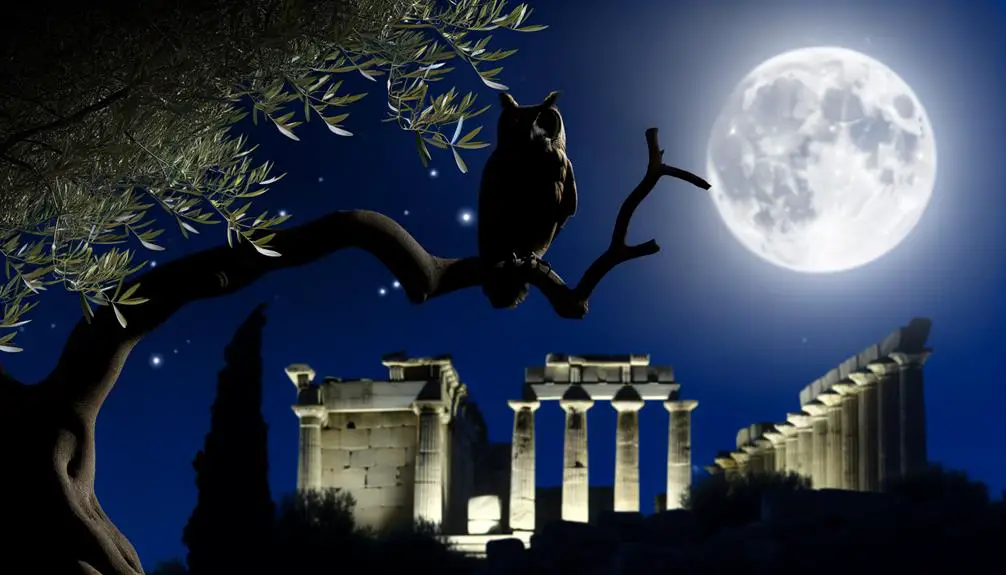
In Ancient Greek mythology, the owl is intimately associated with Athena, the goddess of wisdom and warfare, symbolizing knowledge, vigilance, and astute judgment. The owl, often depicted alongside Athena, serves as an emblem of her intellectual prowess and strategic acumen. Its nocturnal nature and keen vision symbolize an ability to see what others cannot, reflecting the foresight and sagacity attributed to Athena.
In cultural context, the owl's presence in art and literature underscores the value Greeks placed on wisdom and strategic warfare. Interpretatively, the owl's silent flight and sharp gaze may evoke a sense of quiet strength and meticulous observation, qualities revered in both governance and combat. This symbolic association cements the owl's role in Greek thought as a beacon of enlightenment and prudence.
Native American Beliefs

While the owl in Ancient Greek mythology epitomizes wisdom and strategic insight, in Native American beliefs, this nocturnal bird often embodies a complex interplay of meanings, ranging from a harbinger of death to a guide for spiritual journeys.
Various tribes interpret the owl's presence differently; for instance, the Cherokee associate it with witches, while the Hopi consider it a messenger from the spirit world. This multifaceted symbolism reflects the owl's dual nature: feared for its association with the unknown and revered for its perceived connection to intuition and the afterlife.
Consequently, the owl serves as a potent cultural symbol, embodying the paradoxes of life and death, the physical and the spiritual, within Native American traditions.
Eastern Symbolism
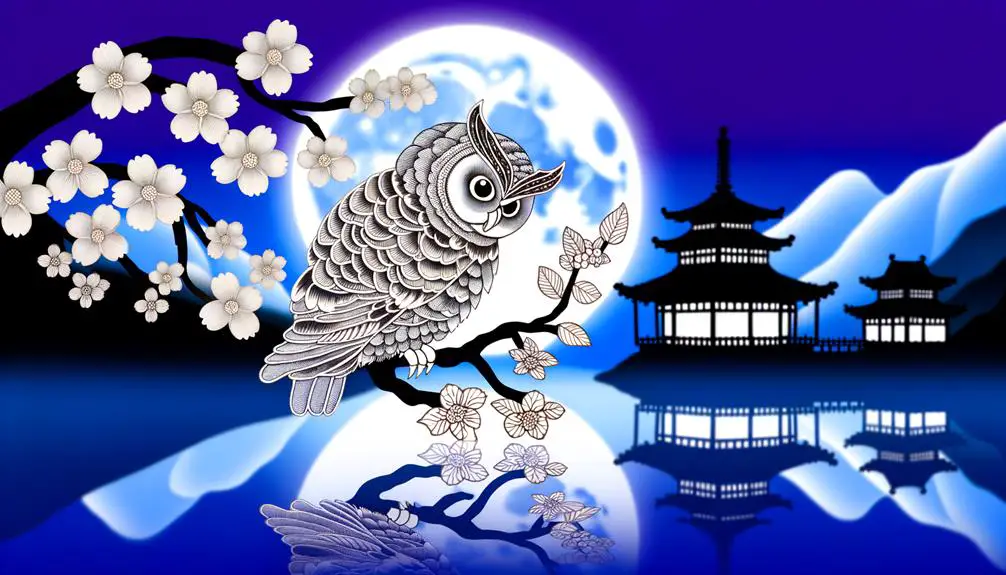
In Eastern cultures, the owl is often revered as an emblem of wisdom and sagacity, reflecting deep philosophical traditions.
Mythological narratives in regions such as Japan and China infuse the owl with symbolic layers that encompass both protective and ominous elements.
Moreover, its spiritual significance in Asia is multifaceted, ranging from harbingers of enlightenment to guardians against misfortune.
Wisdom in Eastern Cultures
Across various Eastern cultures, the owl is often revered as a powerful emblem of wisdom, embodying both the pursuit of knowledge and the mysteries of the unknown.
In Japanese culture, the owl, or 'fukurou,' symbolizes good fortune and protection against suffering.
Similarly, in Hinduism, the owl serves as the vahana (vehicle) of Lakshmi, the goddess of wealth and knowledge, suggesting a deep association with wisdom and prosperity.
In Chinese lore, the owl is viewed with duality: it signifies both auspicious and ominous elements, reflecting the balance of yin and yang.
This multifaceted symbolism underscores the owl's role in guiding souls through darkness, promoting a deeper understanding of life's complexities and the hidden truths within the natural world.
Owl in Mythology
Rooted deeply in the mythological traditions of Eastern cultures, the owl emerges as a profound symbol that intertwines themes of wisdom, protection, and the enigma of the supernatural.
In Japanese folklore, the owl, or 'fukurou,' is often regarded as a talisman for good fortune and warding off suffering.
Similarly, in Chinese culture, the owl is linked to both auspicious and ominous connotations, embodying a duality that underscores its mysterious nature.
Indian mythology presents the owl as a vahana (vehicle) of the goddess Lakshmi, symbolizing vigilance and prosperity.
This intricate tapestry of beliefs demonstrates the owl's multifaceted role in Eastern mythology, reflecting a complex interplay between reverence and caution, wisdom and mystery.
Spiritual Significance in Asia
Merging cultural reverence with spiritual depth, the owl's symbolism in Asia encapsulates a rich tapestry of meanings that span from wisdom and protection to the enigmatic domain of the supernatural.
In Japanese culture, the owl, known as 'fukuro,' is often seen as a harbinger of good fortune and protection against suffering.
Contrastingly, in Chinese folklore, the owl is sometimes associated with dark omens and the mysteries of the night.
Tibetan traditions imbue the owl with spiritual wisdom, seeing it as a guide in the spheres of meditation and enlightenment.
This multifaceted symbolism illustrates the owl's profound impact across various Asian cultures, reflecting a balance between its auspicious qualities and its connection to the mystical and unknown.
Medieval European Views
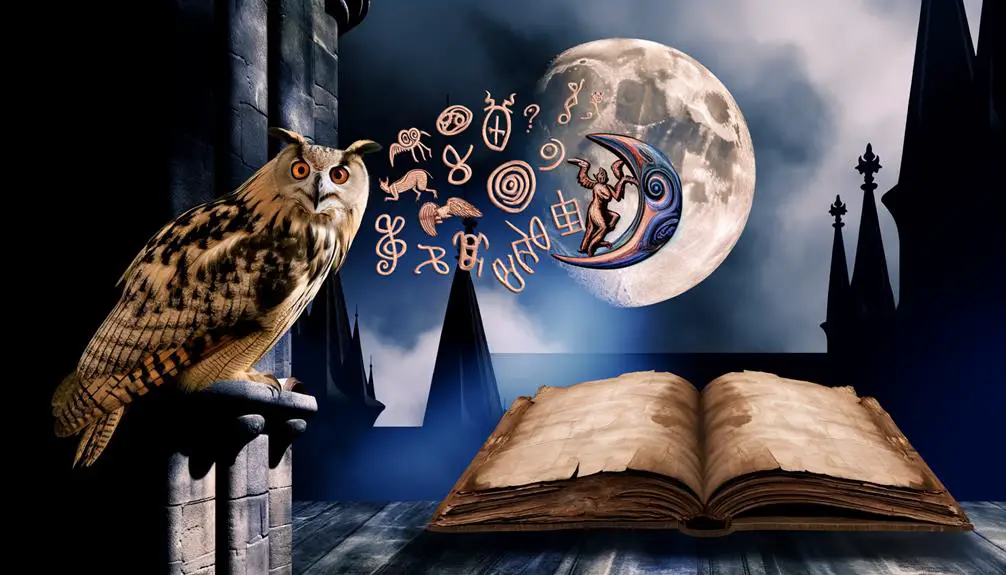
In medieval European culture, the owl was often associated with wisdom and knowledge, yet it also carried connotations of darkness and mystery, reflecting the duality of its symbolic representation during this period.
The owl's nocturnal nature contributed to its perception as a creature of the night, embodying the unknown and often feared aspects of the world. Scholarly texts and folklore frequently depicted the owl as an omen, bridging the domains of the living and the supernatural.
This duality was further emphasized through religious interpretations, where the owl was seen as both a symbol of Christ's solitude and an emblem of heresy. Therefore, the medieval European view of the owl encapsulated a complex interplay between enlightenment and enigma.
Modern Interpretations
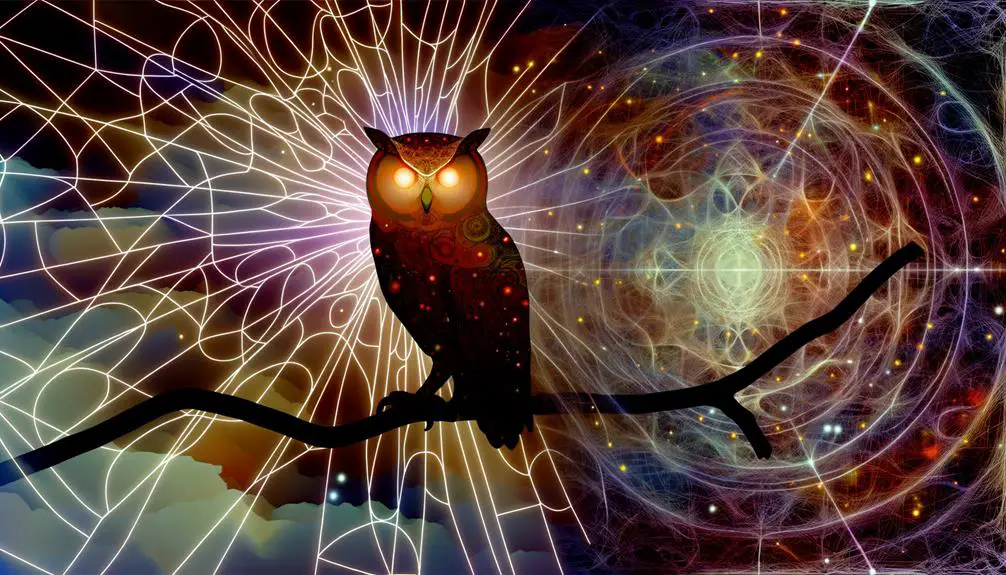
While medieval European perspectives imbued the owl with a blend of wisdom and ominous mystery, modern interpretations have expanded to encompass a broader and more varied spectrum of meanings.
Spiritual Insight: In contemporary spirituality, owls are often seen as messengers of deeper truths and personal revelations, guiding individuals through transformative experiences.
Environmental Awareness: Symbolizing the fragility of ecosystems, the owl has become an emblem of conservation efforts, reminding us of the interconnectedness of all living beings.
Cultural Symbolism: In popular culture, owls frequently represent intelligence and academia, often appearing as mascots for educational institutions and in media depicting scholarly pursuits.
Thus, the owl's symbolism has evolved, reflecting a dynamic interplay of cultural, spiritual, and environmental dimensions.
Literary Significance

The owl's literary significance is deeply rooted in its embodiment of wisdom, often portrayed as a guiding figure in classic and contemporary texts. This symbolic representation is further enriched by its mythological connections, particularly within Greek mythology where the owl is associated with Athena, the goddess of wisdom.
Such interpretations offer a profound insight into how cultural and historical contexts shape the owl's enduring presence in literature.
Wisdom in Literature
Throughout the records of literature, the owl emerges as a potent symbol of wisdom, often embodying the guiding force of knowledge and insight in both classical and contemporary narratives. This emblematic bird frequently appears in works that explore the deeper layers of human understanding and moral discernment.
Key literary examples include:
- Homer's 'The Odyssey': Athena, the goddess of wisdom, is often associated with the owl, symbolizing her role as a protector and guide.
- William Shakespeare's 'Macbeth': The owl's hoot is a forewarning, representing an ominous yet wise premonition of events.
- J.K. Rowling's 'Harry Potter' series: Owls serve as messengers, linking the magical and real worlds, thereby embodying the transfer of knowledge.
These instances underscore the owl's enduring legacy as a harbinger of wisdom in literature.
Mythological Connections
Rooted in the mythological traditions of ancient civilizations, the owl's symbolism extends beyond mere representation of wisdom, intertwining with the divine and the mystical to reveal profound cultural and literary significance.
In Greek mythology, the owl is associated with Athena, the goddess of wisdom and warfare, embodying her strategic acumen and perceptive insight.
In contrast, in Celtic lore, the owl is seen as a guide to the underworld, reflecting themes of death and transformation.
Similarly, in Hindu mythology, the owl serves as the vahana (vehicle) of Lakshmi, the goddess of wealth, signifying vigilance and prosperity.
These mythological connections not only enrich literary narratives but also provide a multifaceted understanding of the owl's enduring symbolic resonance across cultures.
Symbolic Interpretations
Building upon these mythological associations, literary interpretations of the owl symbol frequently emphasize its duality as both a harbinger of knowledge and a portent of mystery. This duality is reflected in various literary works, where the owl embodies profound wisdom and enigmatic forewarnings.
- Insightful Guide: In many narratives, owls guide protagonists towards enlightenment, symbolizing intellectual awakening and clarity.
- Mysterious Messenger: Conversely, owls often herald ominous events or hidden truths, adding layers of suspense and depth.
- Cultural Context: Literature from diverse cultures showcases owls as complex symbols, from the wise Athena's companion in Greek lore to the foreboding creatures in Shakespearean plays.
These interpretations underscore the owl's multifaceted role in enriching literary themes and character arcs.
Artistic Representations
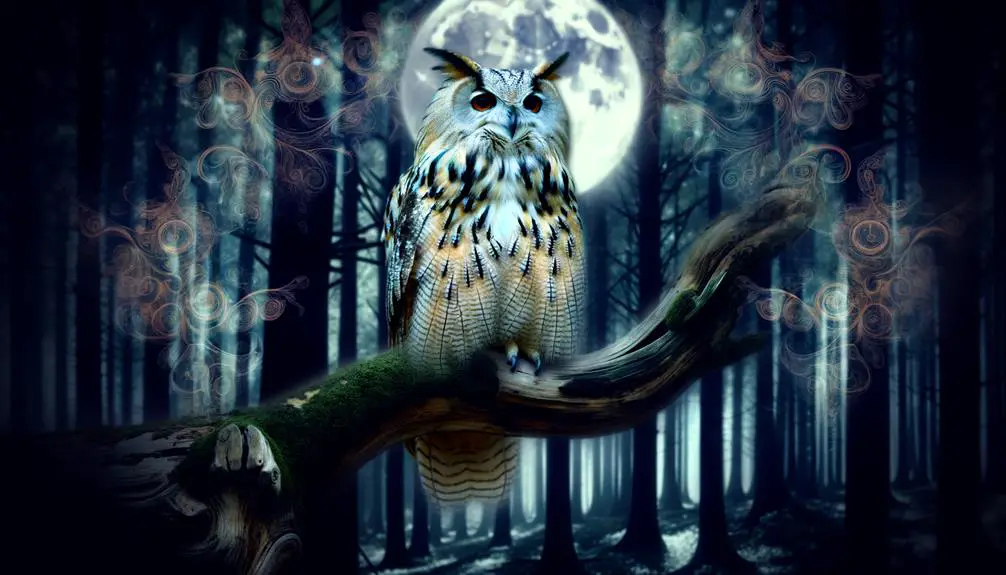
Artistic representations of the owl often draw upon its historical and cultural symbolism to convey themes of wisdom, mystery, and insight. These depictions span across various mediums, each offering a unique interpretative dimension. In ancient Greek art, for instance, the owl is frequently associated with Athena, embodying strategic intelligence. Conversely, in Native American crafts, the owl symbolizes a deep connection to the spiritual world, often seen as a guide through the unknown.
| Culture | Symbolism |
|---|---|
| Ancient Greece | Wisdom, Strategic Intelligence (Athena) |
| Native American | Spiritual Guidance, Mystery |
| Japanese Folklore | Protection against suffering, Good Fortune |
These cultural contexts enrich our understanding of the owl, enabling a multifaceted appreciation of its representation in art.
Conclusion
To sum up, the owl symbol, a multifaceted emblem across various cultures and epochs, embodies a rich tapestry of meanings. From the wisdom of Athena in Greek mythology to the spiritual guides in Native American beliefs, and from Eastern omens to medieval European superstitions, its significance is as diverse as it is profound.
Modern interpretations, along with its literary and artistic representations, further illuminate the owl's enduring allure, akin to a beacon of insight piercing through the fog of human understanding.





